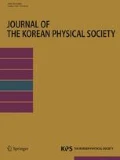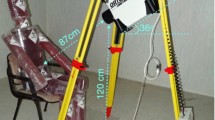Abstract
In this work, scanning is performed in relation to the scan speed for evaluating the applicability of a mobile in situ gamma detector at a decommissioning site, based on the Multi-Agency Radiation Survey and Site Investigation Manual, NUREG-1575. Direct measurements and scanning are conducted under high- and low-concentration hotspot conditions. The high-concentration hotspot fails to meet the release criterion, whereas the low-concentration hotspot complies with the release criterion, despite exceeding DCGLW, and satisfies the elevated measurement comparison test. The maximum and average dose rates measured via scanning in both hotspot conditions are distinguishable from the background dose rate, thus enabling the identification of potential hotspots. In the low-concentration hotspot, photopeak counts appear during real-time scanning; the scanning efficiency exhibited inconsistent trends with respect to the scan speed and hotspot conditions. This study verifies that, at scan speeds less than 18 km/h, the mobile in-situ gamma detector can be applied to identify the hotspots at decommissioning sites and further suggests that direct measurements should also be performed for the quantification of contamination.















Similar content being viewed by others
References
H.-W. Seo, W. Sohn, Scenario options to calculation of Derived Concentration Guideline Levels for a multi-unit decommissioning site. Ann. Nucl. Energy 133, 347–358 (2019)
Multi-Agency Radiation Survey and Site Investigation Manual (MARSSIM), NUREG-1575, Rev. 1, Nuclear Regulatory Commission, Washington, DC, 2000.
E.W. Abelquist, A Decommissioning Health Physics: A Handbook for MARSSIM Users, 2nd edn. (CRC Press, Boca Raton, 2001)
C. Lee, S.-W. Park, H.R. Kim, Development of mobile scanning system for effective in-situ spatial prediction of radioactive contamination at decommissioning sites. Nucl. Instrum. Methods Phys. Res. A: Accel. Spectrom. Detect. Assoc. Equip. 966, 163833 (2020)
C. Lee, H.R. Kim, Preliminary study on rapid measurement of gross alpha/beta and 90Sr activities in surface soil by mobile ZnS(Ag)/PTV array and handheld PVT rod with gated energy channels. J. Radiat. Prot. Res. 46(4), 194–203 (2021)
Maine Yankee LTP, Maine Yankee Letter to the USNRC, MN-09-005 dated February 27, 2009, Revision 3, Maine Yankee License Termination Plan, Wiscasset, ME (2009)
Maine Yankee Letter to the USNRC, MN-04-020 dated March 15, 2004, License Amendment Request: Release of Non-ISFSI Site Land, Proposed Change No. 218, Wiscasset, ME, (2004)
Yankee Rowe LTP, Yankee Nuclear Plant Station License Termination Plan, Revision 1, Yankee Atomic Electric Company, Rowe, MA (2004)
Rancho Seco LTP, Rancho Seco License Termination Plan, Chapter 5, Final Status Survey Plan, ML081990516, Revision 1, Sacramento, CA 200 (2008)
Minimum Detectable Concentrations with Typical Radiation Survey Instruments for Various Contaminants and Field Conditions, NUREG-1507, Nuclear Regulatory Commission, Washington, DC (1998)
Acknowledgements
This work was supported in part by the Nuclear Power Core Technology Development Program of the Korea Institute of Energy Technology Evaluation and Planning (KETEP) (No. 20171520000310), and in part by the Korea Evaluation Institute of Industrial Technology (KEIT) (No. 20014778) grant funded by the Korea government (MOTIE).
Author information
Authors and Affiliations
Corresponding author
Additional information
Publisher's Note
Springer Nature remains neutral with regard to jurisdictional claims in published maps and institutional affiliations.
Rights and permissions
About this article
Cite this article
Park, SW., Lee, C. & Kim, H.R. Applicability of a mobile in situ gamma detector with different scan speeds for evaluating hotspots in decommissioning sites. J. Korean Phys. Soc. 80, 1003–1017 (2022). https://doi.org/10.1007/s40042-022-00481-3
Received:
Revised:
Accepted:
Published:
Issue Date:
DOI: https://doi.org/10.1007/s40042-022-00481-3




